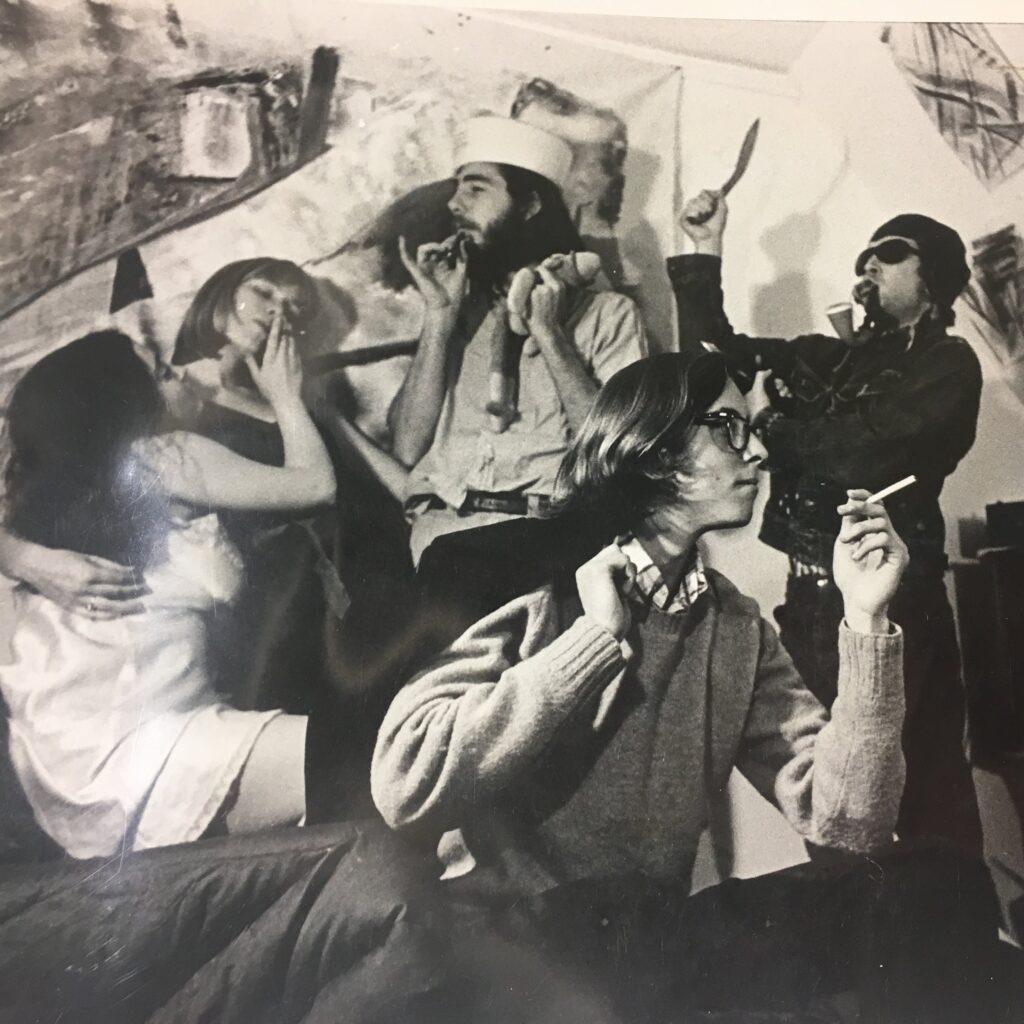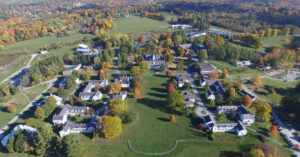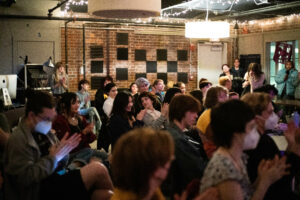
Crossett Library Digital Archives
At a college filled with lucrative and outlandish events, Kilpat’s annual Dress to Get Laid party certainly takes the cake for most talked about. All Bennington parties are themed (Themes this semester have included Fels Down The Rabbit Hole and Boothback Mountain,) but no theme is as iconic as Dress to Get Laid. Kilpat holds the reputation for being the loudest and rowdiest house on campus, so fittingly they host the most lawless party. They have had a rebellious undertone since (at least) the 70s and one of the heartiest histories of any Bennington house. Dress to Get Laid has been around for at least 45 years and takes place every fall term.
In current Bennington times, the name has conceivably become controversial (the idea of just calling it Dress was tossed around in 2021) and more people are morally questioning the event. It still takes place annually, albeit with less overt advertising, but in examining its past, the history is deeply layered.
I talk to Ramaa Mosley, Bennington alum class of ‘95 (and my mother), to inquire about Dress to Get Laid in the 90s. The first thing she tells me about the party is that it “had little to do with getting laid.” Mosley elaborates, “It was about expression and exploring sexual identity. It was ironic, not literal.” When Mosley attended Bennington, the party was not just held at Kilpat. It was all over the place, even taking place in Commons one year. “During that party I was in the mail room of Commons having a talk with a girl who was running the free sex advice column. She had a box in the mailroom that was like ‘ask anything.’” Her favorite Dress to Get Laid costumes over her four years at Bennington were “one man who wore a twin bed attached to his back and a sock covering his genitals” and someone who “wrapped themself in saran wrap to represent a condom.” Bret Easton Ellis went a more fashionable route, one year wearing an Armani suit and a pair of Vuarnets. The name of the party, just like the party itself, has little (no) subtlety, Mosley points out. “That’s the whole point. It’s a provocation,” she says. “It gets into this whole concept of being a slut and what’s acceptable and what’s not in our society. By calling it Dress to Get Laid it’s a provocation.” We both laugh at the irony of this conversation being between mother-and-daughter and the openness of it all. She tells me that while people inevitably hooked up at the event, it turned that into more of a satire than anything else. “It takes that thing that you’re supposed to do at parties and creates its own special event where we are going to unpack all of this. It takes a particular activity and breaks it out so memorably and so creatively.”
Kilpatrick house, established in 1932, was named after William Heard Kilpatrick, one of the founders of Bennington College. He was a driving figure in progressive education. Bennington faculty member Thomas Brockway worked at the college from 1933-1971. He published a book called Bennington College: In The Beginning where he delves into the college’s origins. In the book, the college’s President at the time, President Leigh credits William Kilpatrick for the college’s progressiveness and direction. His principal idea was that education should be self-directed and students should focus on what they want. Dress to Get Laid, in a way, is true to that, creating a meeting place for self-expression and self-direction, in an unmistakably Bennington fashion.
The year after Mosley graduated, in 1996 the administration denied party funds for Dress to Get Laid for the first time. Michael E. Leary, a spokesperson for Bennington said, “The college feels the party’s theme does not describe the reputation of the college or that of its students.” In typical Bennington fashion, students were not pleased with the administration inserting themselves so decidedly into campus culture. A senior at the time told the Associated Press that the administration was “imposing their morality on us.” The list of objections from admin, as published in The Chronicle of Higher Education, included suggestive clothing, alcohol consumption, and “pornographic posters.” The article also suggests that faculty members thought the theme was “offensive to women.” Mosley tells me they got it all wrong. She says, “The party in its original form is supposed to be the exploration of how people put themselves out there when they want to “get laid.” It examines hookup culture at parties, and it has historically been Bennington’s unique way of turning that idea upside down and making it about expression.” Mosley adds, “It became an art piece instead of an intent to seduce in a literal way.”
I sit down with one of Kilpat’s current house chairs, Ayana Sterling, at the Kilpat picnic table. Sterling has lived in Kilpat ever since their freshman year. Sterling has yet to experience a Dress to Get Laid party, due to arriving at Bennington during 2020 pandemic times, and in 2021 the party was canceled at the last minute. Sterling tells me, “We were gonna do Dress to Get Laid last year, it was planned out and everything. We spent hours making our poster. Then a few days before the party there were some sexual assault allegations against two people who had just moved into the house. The timing was crazy. With that happening, we obviously couldn’t do it anymore.” The allegations sent shockwaves through campus in the fall of 2021, and it made sense for the party to be postponed. A year later, Sterling is busy planning the next Dress to Get Laid, soon to take place. The pressure to make the event a success is high, and even more so to maintain a safe environment after the turmoil from the previous year.
Sterling is taking on the brunt of that pressure with goodwill. “I want it to be how it used to be, even though I wasn’t here for it. I’m just really trying to maintain tradition and culture. I don’t want it to be like other house parties at all, I want it to be a completely different experience,” Sterling tells me. They are working with the members of the house to plan in advance and create a cohesive community experience.
This party and its theme are completely unique to Bennington. Mosley tells me what distinguishes it: “No other school has this party and no other school treats the combination of a party and sex as an art form. It was art, sexuality, and a party all combined into one thing. It wasn’t about dressing as attractively as you can, it was about being clever.” Strangely, the thing that she remembers the most about the party in the 90s is how “sweet” it felt. “It was a moment of getting to reflect and explore in a huge room where it felt safe. That was my experience. I would walk in and it was like a scene from a movie. It was a total sensory overload.”
In the 2000s, the party started to become known for something else entirely– the first time in the semester upperclassmen could “morally” hook up with freshmen. It was considered inappropriate pre-October, but as soon as the Dress to Get Laid party took place after October 1st, all bets were off. Catherine Weingarten, Bennington alum, wrote a play while attending Ohio University’s MFA writing program about Dress to Get Laid, where she examines the party and Bennington culture. In an interview about her play, Weingarten says, “I went to the Dress to Get Laid party twice. The time it was the most intense was when I was a freshman cause I just got to Bennington and had no romantic experience at all and was a hyper-prude; so the party was completely overwhelming… I had a crush on this guy who wrote poetry and smoked at me and I really wanted to hook up with him, but it didn’t really happen because he was dressed ironically as a box so I couldn’t really dance with him or get too close.”
In reference to the controversy of the event, Sterling subscribes to the idea that the party is more of a reclamation. “Dress to Get Laid feels like something a lot of the women here on this campus have reclaimed and we know it’s not a literal thing. It’s more like taking charge of your body. I feel like it’s really a party for femmes and women because it’s taking control of your body and I think it’s sick. The history of this party and why we come together and do this is why it’s such a big deal to me. I want people to feel comfortable. Its not like, “Come here to get fucked up and hit on people.” I don’t want that. The title sounds liberating to me. I can understand why they don’t want us to use it anymore,” Sterling says, about the administration’s pushback. “I feel like everyone of every gender and sexual preference should feel comfortable at events and want to have fun, and that’s what this is. I really like the community aspect of it.”
Would Bennington be lesser without Dress to Get Laid? “Hell yeah,” Sterling responds, elaborating: “It’s such a big part of Bennington. This school has so many traditions that have stuck for years and it would be such a loss to get rid of it.” They aren’t however that worried about the theme ending, adding, “Everyone knows around this time KP hosts Dress to Get Laid. You can’t really get rid of history. It’s up to these people if they are going to keep tradition and culture.” Sterling gestures to the campus around us. They are right – It is inevitably up to freshmen and incoming classes who will eventually have to uphold the legacy themselves.
I ask Mosley if, according to her, it would be a loss to Bennington culture if the party was no longer held? She references Casablanca’s zinger, “We’ll always have Paris,” saying “We will always have had that event. You can’t ever take back the history. I wish you could experience the version I experienced because I think it helped me grow as a person and develop my own confidence, but regardless it will always have been.” With resonance, she concludes, “Sometimes things have to change. Now it’ll be something new.”

Dress to Get Laid ’97 (unknown source)





Be First to Comment